Gamification, or the addition of game-like elements to anything that isn’t a game, pops up all over the design world.
In my last post for Boxes and Arrows, I focused specifically on gamification in mobile app onboarding. The moment when users first open your app is critical to the app’s success, and you can use gamification as a tool to get a new user through the learning curve.
But gamification doesn’t just fit with onboarding. It’s possible to apply gamification to any part of app design, or even design an entire app—that is not a mobile gaming application—around it.
I’ll examine Forest, a productivity app, as a case study of gamification embedded so deeply into an app’s framework that gamification becomes the entire reason to use the app in the first place.
What is Forest?
In 2015, Shaokan Pi, a Taiwanese mobile app publisher, released an app called Forest. Tech-oriented media outlets latched onto Forest immediately, and it appeared in articles like “Top 10 Productivity Tools to Maximize Your Efficiency” and “Curb Tech Dependence With an App That Plants Trees as a Reward.”
For all that praise, Forest doesn’t do very much. It has a single goal: Grow virtual trees. When you plant a tree in your personal forest, you have to leave your phone alone for a time of your choosing (25 minutes, typically). If you use any other app during that time, the tree dies. Should you succeed, though, you start a customizable grove. That’s it. You can’t convert the trees into money, for example, or coupons.
Forest does have a second goal, but it’s an extension of the first: Grow enough pixelated trees, and Shaokan Pi’s nonprofit partner, Trees for the Future, plants a real tree in Senegal, Cameroon, Uganda, Kenya, or Tanzania.
How does Forest entice users?
The genius of Forest is that it gamifies the act of tuning out technology. The app hints at driving users away from the very device that makes Forest possible in the first place, and somehow, users love Forest for it. The app has a five-star rating and over 2,300 reviews on the Apple App Store.
When users first open the app, explainer text tells them what Forest does.
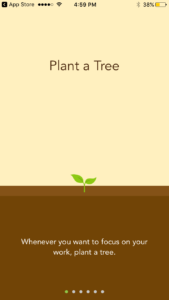
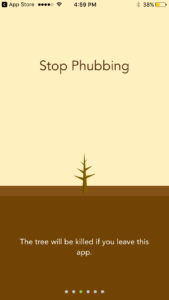
After less than five seconds, a user is planting her first tree. If she leaves the app, she gets a single warning before her sapling dies.
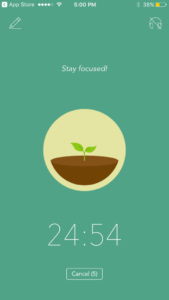
I can personally attest to how effective this warning is. Whenever I use Forest, I go to great lengths to keep my tree alive. I have even ignored calls from my mother. The reason? Probably dopamine. In my last article, I talked about our brains, which release dopamine when we achieve something. It doesn’t have to be something significant, mind you—it can be anything.
Forest rewards users with an image of a tree after 25 minutes of concentration. That doesn’t seem like much of a reward, but consider what users get out of the app. The tree is only a marker for the real achievement, concentration. Gamification is all about a task-and-reward setup, and concentration is the reward.
Few apps can claim that the reward they provide is distraction-free focus, or to deliver the reward by making users promise not to interact with
anything during the concentration period.
This may make it seem like Forest isn’t a game at all. However, the app does feature some gamification trademarks.
How does Forest get users to stay?
Personalization, a purchase system, and consistent attitude reinforcement are two key markers in Forest that show how much the app relies on gamification.
When new users finish a concentration period, the tree they’ve grown is only the app’s most basic kind. At the moment, Forest offers over twenty-five plant varieties, as well as several ambient tones users can play in the background as they concentrate.
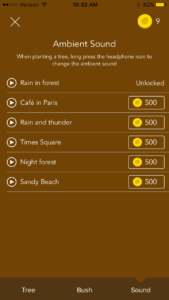
Users can choose the type of tree when they begin a session, and their virtual gardens grow more vibrant with each tree they plant.
But to unlock each tree type, a user has to pay 500 coins.
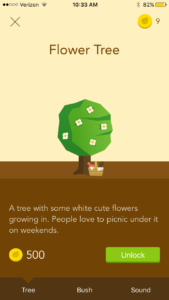
Every 25-minute session nets you 9 coins, which amounts to 55.5 sessions, or 23.1 hours total.
This personalization-through-purchase setup is classic gamification. The app’s basic experience is fine, Forest suggests, but wouldn’t it be better if users had a deluxe experience, complete with gingko and cherry blossom trees and the sound of a Parisian café? To achieve that deluxe experience, users must dedicate serious time to the app.
Another way Forest uses gamification techniques is in its consistent negative reinforcement.
If a user tries to exit the app during a concentration period, she’ll get a notification that says, “Stop phubbing!” And if she hasn’t grown any trees in her forest, a wooden sign with a frown carved in it signals that the app is disappointed.
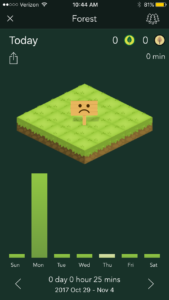
The user should plant a tree, the sign suggests, and the frown surrounded by empty grass will disappear.
Conclusion
Forest walks the tightrope between a total rejection of gamification and a completely gamified system. The app’s core activity, focusing, encourages the user to step away from technology entirely. Meanwhile, the personalization-through-purchase and negative reinforcement make it clear that the user is supposed to use certain behaviors to get more and greener trees.
This balance is why Forest, as both a mobile app design and as an experience, is ingenious.
